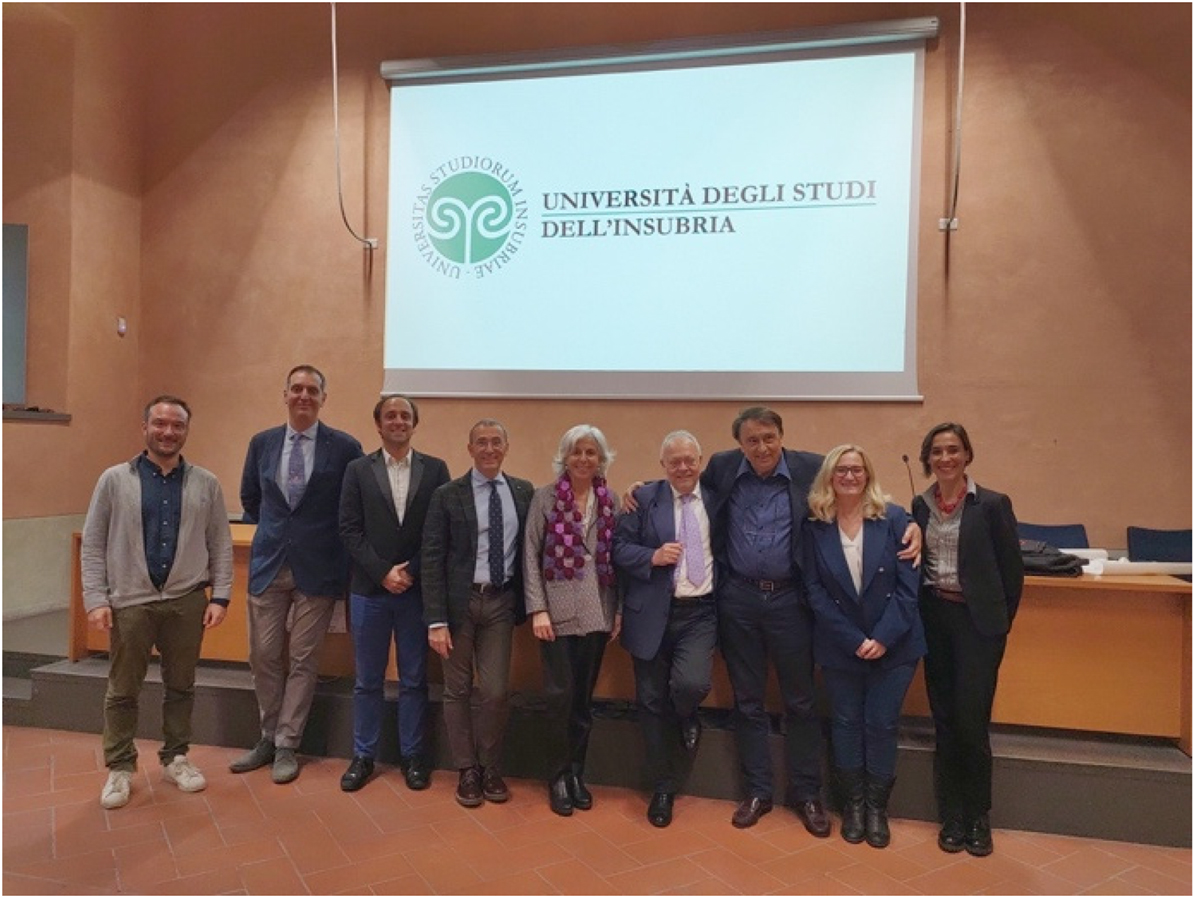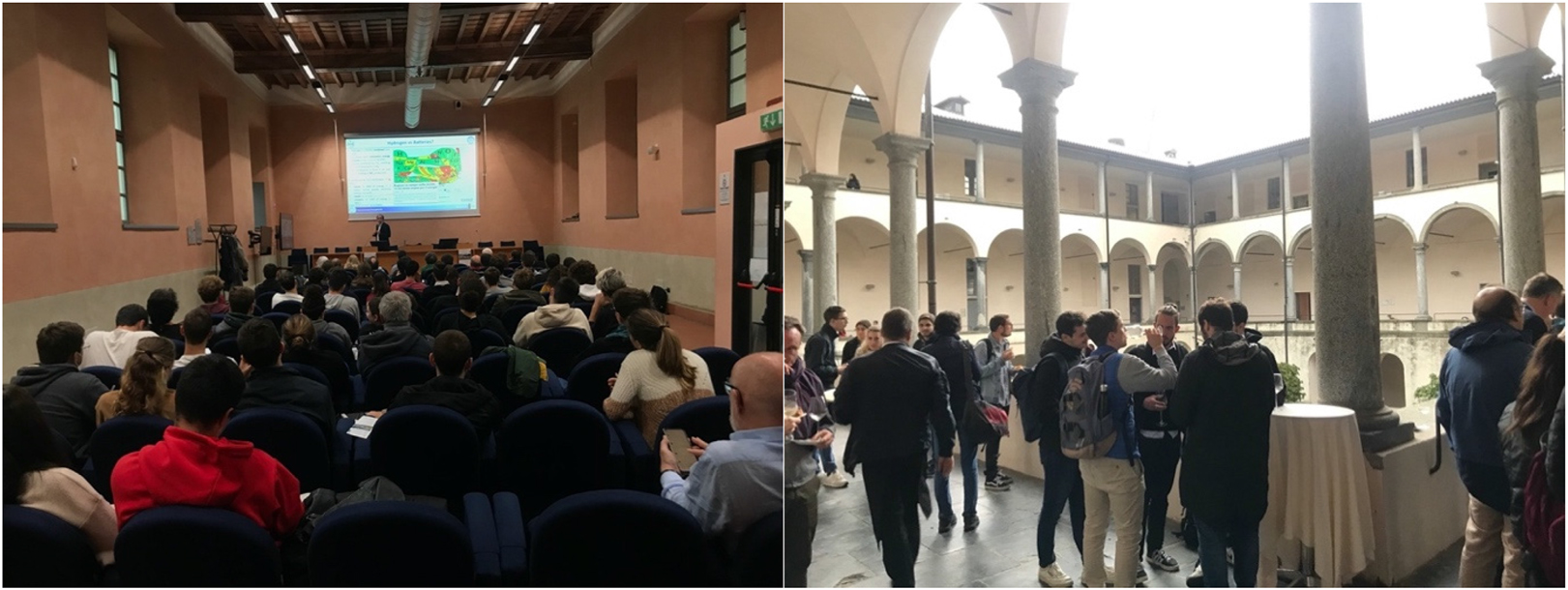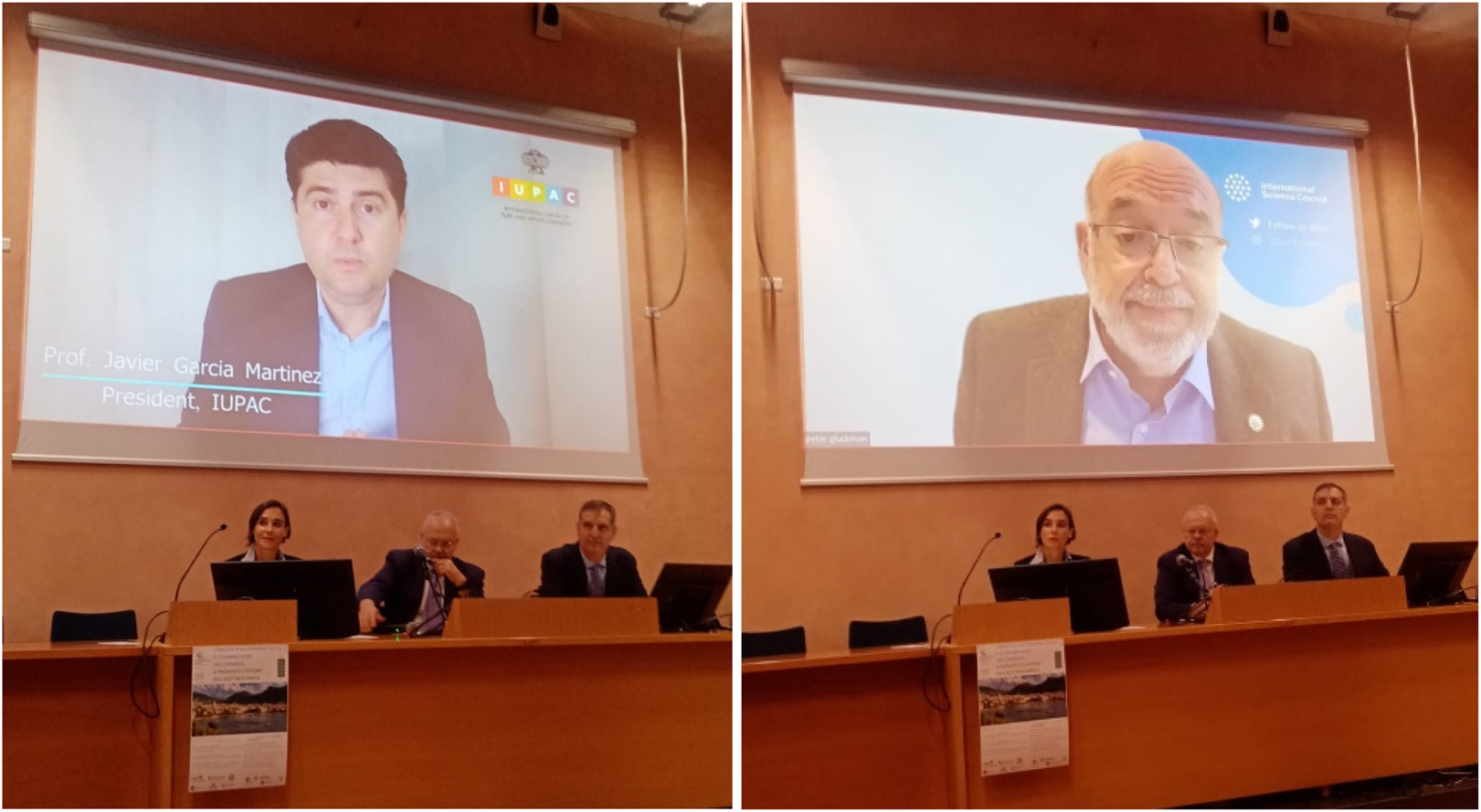The extraordinary invention of the “voltaic” battery, published by the great and creative Italian scientist Alessandro Volta in 1800, opened the way to electrochemistry, a lively branch of chemistry that is extremely relevant today to face the challenges of sustainability.

The organizers and the speakers of the event. From left to right: A. Minguzzi, M. Guidotti, F. Bella, A. Pozzi, A.M. Paci, M. Peruzzini, L. Fabbrizzi, C. Arbizzani, S. Borsacchi.

Participants of the workshop in the Sant’Abbondio cloister (Como).

Video messages of the IUPAC president, J. Garcia Martinez and of the ISC President, P. Gluckman.
The intense and multifaceted history of electrochemistry, from its origin to the most promising developments, have been the focus of an open educational event held in Como, the birthplace of Alessandro Volta, on October 24th, 2022, in the framework of the International Year of Basic Sciences for Sustainable Development (Figs. 1–3). The event was organized by the Italian IUPAC NAO, with the support of IUPAC CHEMRAWN Committee (IUPAC project #2022-018-1-021), in collaboration with the International Science Council, the Italian National Research Council and the University of Insubria based in Como. The president of IUPAC, Javier Garcia Martinez, and the President of ISC, Peter Gluckman, opened the event with two supportive video-messages, highlighting the importance of history and the need of fundamental sciences for achieving a sustainable development. Then three highly qualified Italian chemists, Prof. Luigi Fabbrizzi (Emeritus of the University of Pavia), Prof. Catia Arbizzani (University of Bologna) and Prof. Federico Bella (Polytechnic of Turin), led the audience in an exciting journey traversing the chemistry from late-1700 to the future, starting from the origins of electrochemistry, through the history of batteries, up to their crucial role in the current energy transition aimed at decarbonizing our economy, with a strong emphasis on the importance of interdisciplinarity. The three lectures stimulated a lively interesting discussion through a round table in which the speakers discussed with Prof. Francesca Kerton, Chair of IUPAC CHEMRAWN Committee and Prof. Lidia Armelao, Chair of the IUPAC Division II (Inorganic Chemistry) and current Director of CNR-DSCTM (Department of Chemical Sciences and Materials Technology). The discussion highlighted the involvement of chemistry and the need for chemists to work together to achieve the different UN SDGs, from energy to the environment to the eradication of hunger, paying particular attention to multidisciplinary and multinational collaborations to address the current challenges. This is particularly crucial for electrochemistry, especially for optimizing materials, carefully choosing non-critical elements, and for developing recyclable and reusable devices. From the discussion the need to establish specific multidisciplinary university curricula aimed at training specialists in fundamental electrochemistry and its application to batteries, which are increasingly necessary, clearly emerged.
As a follow-up of this interesting and stimulating event, both Fabbrizzi and Arbizzani accepted to write two contributions for Pure and Applied Chemistry, to help readers travelling through the life of Alessandro Volta and the history of batteries, from their origin to the present and future challenges represented by lithium ion and other light high-performing batteries.
As organizers of this event, we thank both speakers and participants, for creating a stimulating reflection on electrochemistry, one of the most important topic that chemistry can offer to humanity to achieve a true sustainability. Furthermore, we are indebted to all the sponsors of the day: IUPAC, the Lombardy section of the Italian Chemical Society (SCI), the Royal Society of Chemistry – Italy Section, the International Society of Electrochemistry and the De Nora Foundation. The video recording of the event is available on the Italian NAO website (www.iupac.cnr.it).
A news feature on the event was published in Chemistry International: Borsacchi, S., Guidotti, M., Sanson, A., Minguzzi, A., Pozzi, A., Paci, A. M., Kerton, F. and Peruzzini, M. “Alessandro Volta: Still Fully Charged After 200 Years” Chemistry International, vol. 45, no. 2, 2023, pp. 17-21. https://doi.org/10.1515/ci-2023-0205
Funding source: IUPAC- CHEMRAWN Committe
Award Identifier / Grant number: project #2022-018-1-021
© 2023 IUPAC & De Gruyter
Articles in the same Issue
- Frontmatter
- In this issue
- Editorial
- Electrochemistry: from Alessandro Volta’s genius to the future
- Conference papers
- From Volta’s pile to lithium ion battery: 200 years of energy
- The invention of Volta’s Pile and its diffusion in Europe at war in the year 1800
- IUPAC Technical Report
- Analytical chemistry of engineered nanomaterials: Part 2. analysis in complex samples (IUPAC Technical Report)
Articles in the same Issue
- Frontmatter
- In this issue
- Editorial
- Electrochemistry: from Alessandro Volta’s genius to the future
- Conference papers
- From Volta’s pile to lithium ion battery: 200 years of energy
- The invention of Volta’s Pile and its diffusion in Europe at war in the year 1800
- IUPAC Technical Report
- Analytical chemistry of engineered nanomaterials: Part 2. analysis in complex samples (IUPAC Technical Report)

